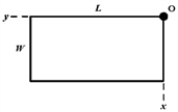Multiple Choice
A tennis player wants to slam a serve at O so that the ball lands just inside the opposite corner of the court. What should the ratio  be for the initial velocity
be for the initial velocity  ? The time t = 0 is the time when the ball is hit by the racket.
? The time t = 0 is the time when the ball is hit by the racket. 
A) W/L
B) L/W
C) 
D) 
E) 
Correct Answer:

Verified
Correct Answer:
Verified
Related Questions
Q11: A rifle is aimed horizontally at the
Q21: A tennis player standing 12.6 m from
Q22: The site from which an airplane takes
Q28: <br>Newton approximated motion in a circle as
Q29: Two cooks standing side by side in
Q30: Two balls, projected at different times so
Q31: A fast duck is flying <img src="https://d2lvgg3v3hfg70.cloudfront.net/TB8847/.jpg"
Q54: A rock is projected from the edge
Q60: A car is driven 1200 m north
Q63: A student in the front of a